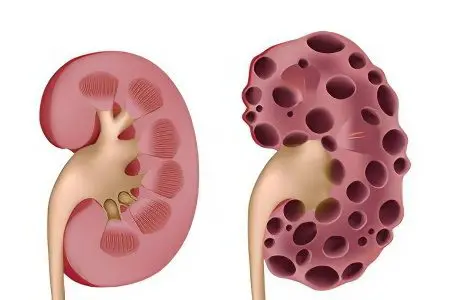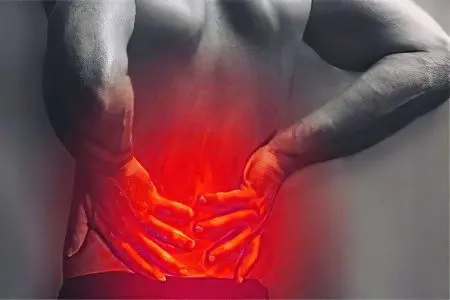Contents

Acute renal failure is a sudden onset of a pronounced violation, or a complete stop of the functioning of the kidneys. This pathological process is potentially reversible, although during it all the functions of the kidneys suffer – excretory, filtration and secretory.
According to available statistics, out of every million people in Europe, acute renal failure develops in about two hundred people. More than 50% of pathology cases are caused by operations on the heart or large vessels, as well as multiple injuries. From 15 to 20% of cases of acute renal failure occur in obstetric practice. In addition, over the past 10 years, there has been an increase in the number of cases of acute kidney dysfunction associated with taking medications. It is noteworthy that in African countries, renal failure develops mainly against the background of a viral or parasitic infection. While in European countries the cause is most often arterial hypertension and diabetes mellitus.
Causes of kidney failure
The causes of renal failure are multiple, but they are all combined into three large groups, which at the same time represent forms of the disease.
Causes of prerenal kidney failure (hemodynamic form):
Decrease in cardiac output, which is observed in heart failure, arrhythmia, cardiogenic shock, pulmonary embolism, cardiac tamponade;
A pronounced decrease in the level of extracellular fluid, which may be due to diarrhea, prolonged vomiting, severe blood loss, dehydration, burns, ascites against the background of cirrhosis;
Intestinal obstruction, peritonitis, acute pancreatitis, as conditions leading to fluid sequestration in tissues;
Vasodilation of systemic genesis against the background of sepsis, anaphylaxis, endotoxic shock or taking vasodilators.
Causes of renal insufficiency of the kidneys (parenchymal form):
Toxic effect on the kidney parenchyma of poisons, fertilizers, cadmium, mercury, uranium, copper salts. It is possible to develop a pathological condition against the background of bites of poisonous snakes and insects;
Uncontrolled intake of drugs that have a toxic effect on the kidneys. Among these are sulfonamides and some other antibiotics, antitumor agents. If a person already has impaired kidney function, then the introduction of contrast agents to perform an x-ray examination, as well as all of the listed drugs, can cause acute failure, even if the dosage is observed;
An increase in the level of hemoglobin and myoglobin in the blood with a coma of alcoholic or narcotic origin, with inappropriate blood transfusion, with macrohemagglobinuria, against the background of prolonged tissue compression;
Inflammation of the kidneys, although rare, can still lead to the development of kidney failure. This is glomerulonephritis, tubulointerstitial nephritis;
Infectious diseases – hemorrhagic fever with severe renal syndrome, viral hepatitis, leptospirosis, HIV infection, etc.;
Removal of one kidney or its injury.
Causes of postrenal kidney failure (obstructive form):
Urolithiasis with obstruction of the urinary tract by stones, which leads to a violation of the passage of urine;
Tumor of the prostate gland, ureters, bladder;
Dystrophic lesions of the retroperitoneal tissue;
Urethritis, periurethritis;
Tuberculosis of the kidneys;
Accidental ligation of the ureter during surgery.
Sometimes a combination of several factors that provoke renal failure is possible.
Stages and symptoms of kidney failure

Symptoms of kidney failure will vary depending on the stage of the disease:
Symptoms of the initial stage of the disease. The patient’s condition will be determined by the disease that provoked renal failure. Therefore, a person is not able to independently determine its manifestation, the pathogenesis is veiled by the symptoms of the etiological factor. The circulatory collapse, although it occurs, is short in time and therefore remains unnoticed. Such symptoms of impaired functioning of the kidneys, such as loss of appetite, nausea and weakness, the patient refers to the injury, poisoning or other condition that led to the manifestation of the process of renal failure.
Symptoms of the oligoanuric phase of the disease. The complete absence of excreted urine is rarely observed, but its volumes are significantly reduced (up to 500 ml or less per day).
In addition, there are such violations as:
Severe proteinuria – a high protein content is found in the urine;
Azotemia – an increase in the content of nitrogenous metabolic products in the blood;
Hyperphosphatemia – an increase in the level of phosphates in the blood;
Metabolic acidosis with nausea and vomiting, drowsiness, increasing weakness, shortness of breath and shortness of breath;
Arterial hypertension is diagnosed in 20-30% of patients;
Hypernatremia – an increase in the sodium content in the interstitial space;
Hyperphosphatemia – an increase in the level of phosphates in the blood;
Acute uremia provokes damage to the liver (with its increase in size) and other organs of the gastrointestinal tract. Perhaps the development of gastrointestinal bleeding due to ulcers, which is found in 10-30% of cases.
Against the background of hyperhydration, pulmonary edema is possible, which is expressed in the occurrence of wet rales, the appearance of shortness of breath. In addition to the fact that the patient becomes inhibited, there is a threat of entering a coma.
Another common symptom of this stage of the disease is pericarditis and uremic gastroenterocolitis. Often these conditions are complicated by bleeding.
Against the background of a weakening of the immune forces, infection may be added. The development of sepsis, pancreatitis, stomatitis and pneumonia is not excluded. Acute infections significantly worsen the condition of patients.
This stage develops in the first three days after the organism was affected by one or another etiological factor that led to renal failure. The oligoanuric stage lasts from 10 days to 2 weeks, but can be reduced to several hours, or stretched for 2 months. If the oligoanuric stage lasts more than 4 weeks, it is necessary to exclude renal vasculitis, glomerulonephritis, necrosis of the renal cortex.
Symptoms of the recovery stage of diuresis. A striking symptom of this phase is polyuria, which develops against the background of the fact that the destroyed renal tubules have lost their ability to reabsorb. Daily diuresis gradually increases and can range from 2 to 5 liters. Water and electrolyte balance gradually returns to normal. However, there is a danger of developing hypokalemia due to the leaching of potassium in the urine. This phase lasts an average of two weeks. If the patient receives therapy that is inadequate to the situation, then dehydration, hypophosphatemia, and hypocalcemia may develop.
Symptoms of the stage of full recovery. At this time, the functioning of the kidneys is restored to its original level. This period can take from six months to a year. However, it is possible that acute renal failure will develop into chronic. This occurs when most of the kidney tissue is affected.
Complications of kidney failure
Complications of renal failure depend on how severe the disorders of the organs are, as well as on the presence of oliguria. It is against the background of bright oliguria that a drop in the level of glomerular filtration occurs, which reduces the flow of electrolytes, nitrogen metabolism products and water. As a result, the composition of the blood suffers greatly.
Failures in water-salt metabolism. The most dangerous in this regard is hyperkalemia, since against its background, patients begin to complain of muscle weakness, sometimes tetraparesis and bradycardia form. The higher the concentration of potassium in the blood, the higher the risk of cardiac arrest.
Blood disorders. Since the level of nitrogen in it rises, this causes the rapid death of red blood cells. As a result, such a complication as normocytic normochromic anemia develops.
Violations in the functioning of the immune system. This leads to the fact that patients develop various infections, which occurs in 30-70% of cases. Complications in the form of immune disorders are very dangerous, since it is the associated infections that most often lead to death. The oral cavity suffers, postoperative wounds do not heal for a long time, damage to the respiratory and urinary systems is possible. Sepsis, as the most formidable complication of insufficiency, is usually provoked by gram-negative and gram-positive bacteria.
Violations of the nervous system are manifested in the fact that a person has confusion, lethargy, which is replaced by excitation. Possible disorientation in space. Neuropathy often develops in old age.
On the part of the cardiovascular system, complications such as arrhythmia, congestive heart failure, arterial hypertension are possible.
On the part of the work of the digestive organs, complications such as nausea, vomiting, abdominal pain, lack of appetite, bleeding against the background of gastroenterocolitis are possible.
Diagnosis of kidney failure

Diagnosis of kidney failure includes the delivery of a variety of tests, including:
Blood to determine the level of potassium, nitrogenous compounds;
Urine sampled Zimnitsky;
Biochemical blood test with determination of the level of urea, electrolytes, creatine;
Urine is also sent for general and bacteriological analysis.
Deficiency is detected by examining the bladder. There is no urine in it. It is important to distinguish between anuria and acute urinary retention, which can also accompany insufficiency. When the organ is overfilled with urine, anuria does not develop.
As for instrumental methods of examination, it is necessary to perform an ultrasound of the bladder and kidneys to determine the form of insufficiency. It will be possible to judge the presence or absence of urinary tract obstruction.
Ultrasound of the kidney vessels is performed to assess blood flow in the organs. A kidney biopsy is performed to make a differential diagnosis.
A chest x-ray may be performed to rule out pulmonary-renal syndrome and pulmonary edema. Chromocystoscopy is indicated if there is a suspicion that the orifice of the ureter has undergone obstruction.
An electrocardiogram is taken for each patient with renal insufficiency in order to detect arrhythmia in time.
How to treat acute renal failure?
Treatment of renal failure is determined primarily by the stage at which the disease is located, as well as by the factor that provoked the development of the pathological process. The success of therapy also depends on the close interaction of the patient with nephrologists and urologists.
The primary goal is to eliminate the etiological factor that caused the failure of the kidneys. In parallel, measures are being taken to eliminate the existing shock, to normalize the work of the heart, to replenish blood loss. It is important that the vessels are in good shape, and the blood flow in the kidneys is restored.
Detoxification measures should be carried out in the case when the patient was poisoned by salts of heavy metals, which led to the development of insufficiency. These are measures such as taking enterosorbents, gastric lavage, hemosorption.
To rid the patient of postrenal insufficiency, it is necessary to remove the obstruction of the urinary tract. For this, catheters can be installed in the ureters, nephrostomy and pyelostomy are performed.
In order not to provoke hyperhydration, water intoxication, it is necessary with special care to control the volumes of fluid prescribed to the patient during the oliguric and anuric period.
All forms of kidney failure require the placement of a person in a hospital. According to indications, hemodialysis is performed on him. Sometimes it is performed before surgery – before a nephrostomy or before a pyelostomy. Surgery is performed on the kidney that functions better. The evaluation criterion in this case are clinical signs. Pain will always be more intense where the kidney works better. After anuria can be eliminated, the patient is prescribed drugs aimed at normalizing renal blood flow and increasing the rheological properties of blood.
Hemodialysis
It should be taken into account that hemodialysis can save the life of even the most difficult patients, so it should not be abandoned. It is effective even in arenal forms of pathology, when the patient’s condition is very difficult. After hemodialysis, it becomes possible to perform a kidney transplant.
Indications for hemodialysis by artificial kidney:
Lack of effect from conservative treatment.
The level of creatine in the blood is more than 114 mmol / l.
Residual nitrogen exceeds 113 mmol/l.
urea above 49 mmol / l.
Visiting resorts for the purpose of preventing pathology is advisable no earlier than six months after the patient was discharged from the hospital.
Prognosis of the disease
As for the prognosis for recovery, it completely depends on the severity of the course of the disease, on the age of the patient and on how successfully the cause that led to the acute impairment of kidney function can be treated. With adequate therapy, complete recovery is observed in 35-40% of cases, partial – in 10-15%. Up to 3% of patients will need permanent hemodialysis. The renal form of the disease is considered especially unfavorable in this regard. After it, more than 40% of patients are transferred to permanent hemodialysis.
The death of patients occurs due to uremic coma, from sepsis and hemodynamic disorders. Oliguria worsens the prognosis. The uncomplicated course of the pathology that developed initially makes it possible to predict full recovery in 90% of cases. However, an important condition is the timely appeal to the doctor.
[Video] Dr. Berg – #1 Food for Kidney Disease. How to support kidney health:









